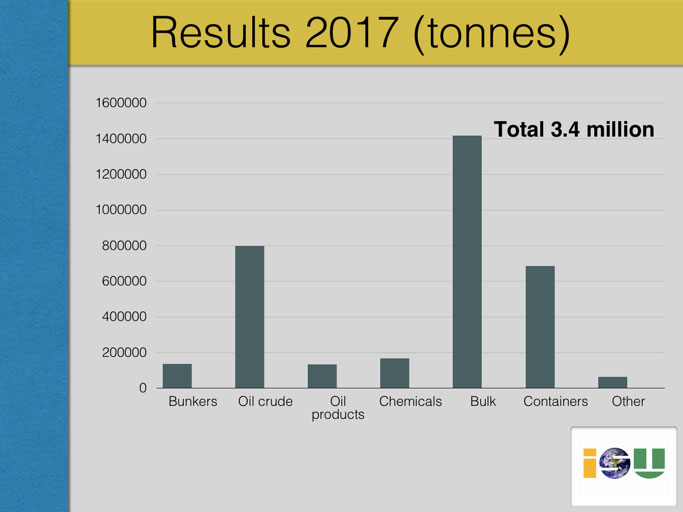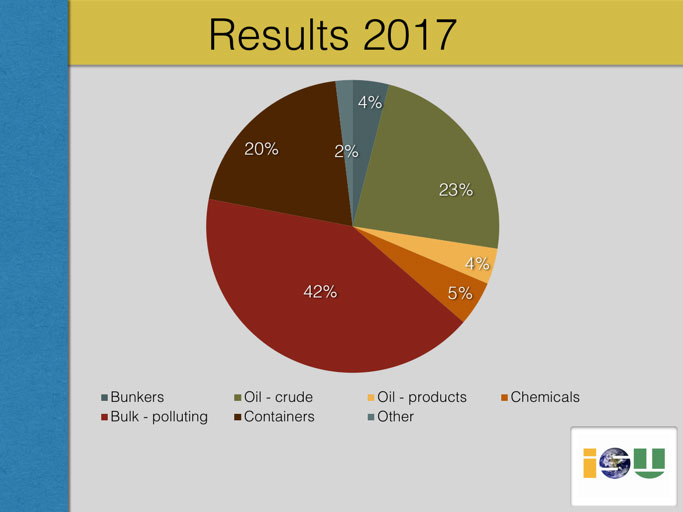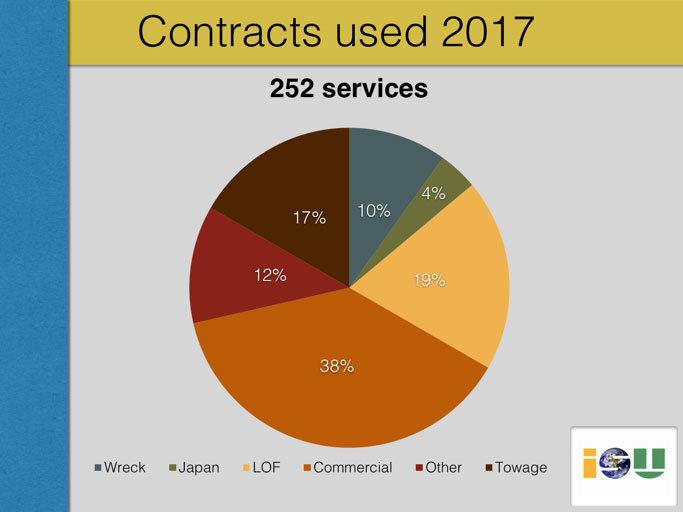Issued 14 March 2018
International Salvage Union members’ operations in 2017 involved vessels carrying more than 3.4 million tonnes of potential pollutants
Members of the International Salvage Union (ISU) provided 252 services to vessels carrying 3,405,477 tonnes of potentially polluting cargoes during operations in 2017. It is a significant increase on the previous year and shows the importance of ISU members’ role in protecting the marine environment.
The data come from the results of the ISU’s 2017 Pollution Prevention Survey. The survey was re-based in 2014 to include a wider range of potential pollutants including containers and hazardous and dirty bulk cargoes.
The most significant factor in the increase in 2017 is a larger number of bulk cargoes. This category includes products such as ammonium nitrate, coal, scrap steel, grains, soya and cement. A number of bulk cargoes are not included as potential pollutants, however, ISU members also provided services to bulkers carrying 845,976 tonnes of non-hazardous dry bulk – chiefly ores.
The 2017 numbers also record a significant increase in the number of containers involved in salvage cases, rising from 21,244 TEU in 2016 to 45,655 TEU in 2017. It reflects the size of containerships – a small increase in the number of boxship salvage cases can add significantly to the TEU total.
Bunker fuel, at 135,995 tonnes, showed a significant increase on 2016’s figure of 89,492 tonnes. That is largely explained by the increased number of services provided. A number of services within the total did not record the quantity of bunkers on the vessel or the cargo type.
Commenting on the results of the survey, President of the ISU, Charo Coll, said: “After saving life, protection of the marine environment is the priority in all salvage operations. The results of this survey demonstrate clearly of how our members’ services have helped to protect the marine environment from potential damage.
“ISU does not suggest that all of these potential pollutants were at imminent risk of going into the sea. Some cases will have been benign but others will have carried a real environmental threat. It only takes one major incident to cause an environmental disaster so it is worth considering what might have occurred in some of these cases if there had not been a professional salvor available and willing to intervene. Our members have undoubtedly helped to prevent the environmental and financial consequences of a significant pollution event.”
2017 ISU Pollution Prevention Survey Results (tonnes)
| 2017 | 2016 | |
| Number of services | 252 | 213 |
| Bunker fuel | 135,995 | 89,492 |
| Crude oil | 798,620 | 705,148 |
| Refined oil
products |
134,488 | 544,742 |
| Chemicals | 168,784 | 109,864 |
| Bulk polluting/hazardous | 1,418,344 | 859,531 |
| TEU – tonnes
equivalent |
684,825 (45,655
TEU@nominal 15 tonnes/TEU) |
318,360 (21,224
TEU@nominal 15 tonnes/TEU) |
| Other pollutants | 64,421 | 56,762 |
| Totals | 3,405,477 | 2,683,899 |
The survey was first conducted by ISU in 1994 and the methodology was updated in 2014. It takes account of the fact that coastal state authorities consider most cargoes to be potentially polluting. Container trade has also increased dramatically and the capacity of boxships is now far greater than in 1994. Containers, with mixed and sometimes hazardous contents – and the danger they cause if left in the sea – are both a potential pollutant and hazard.
The survey takes account of the International Convention on the Prevention of Pollution from Ships (MARPOL), the International Maritime Dangerous Goods Code (IMDG Code), Intercargo guidance, P&I Club guidance; International Tanker Owners Pollution Federation publications and the International Solid Bulk Cargoes Code.
In 2017 ISU members provided 252 services (213 in 2016). Variants of wreck removal contracts were used in 25 services; Lloyd’s Open Form – 49 services; towage contracts – 42 services; Japanese Form – 10 services; Fixed Price – 1 service; Day Rate – 78 services; lump sum – 17 services and other contracts were used in 30 services.
In the period 1994 to end-2017, ISU members have provided services to casualty vessels carrying 28,206,376 tonnes of potential pollutants, an average of more than one million tonnes per year.
Results 2017 (tonnes)



